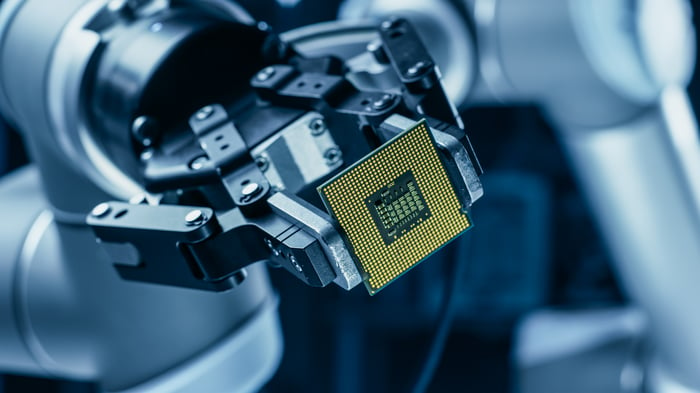The new year has just begun, but the best investment strategy in 2022 won't differ all that much from the best plan in 2021: Focus on the long term. Recent stock market volatility, especially in technology stocks, can tempt investors to make short-sighted decisions -- but this should be avoided.
History supports the argument that time in the market is better than timing the market. Buying quality stocks and exercising patience is a recipe for success, especially if the companies have strong earnings and a high growth rate. That's why these two stocks are prime candidates to deliver fourfold returns by 2030.

Image source: Getty Images.
1. The case for Upstart
Artificial intelligence (AI) will be one of the most transformative technologies of our time. It's being applied in almost every industry in existence, mostly behind the scenes to complete complex tasks that once required thousands of hours of human input. Upstart Holdings (UPST -0.44%) is leveraging AI to transform lending, challenging the decades-old FICO credit scoring system used to assess potential borrowers.
The company's AI algorithm can assess over 1,000 data points to form a more comprehensive view on a person's creditworthiness, and 67% of the time it delivers an instant decision. Typically, this would raise concerns about its accuracy, but Upstart-approved borrowers default up to 75% less of the time compared to those assessed the traditional way.
Upstart earns revenue through fees when it originates a loan for a bank, so it takes no credit risk itself. After building its foundations in unsecured loan originations, it's now tackling the much larger automotive finance market, partnering with 291 dealerships all over America using its new Upstart Auto Retail sales and lending software. That dealership footprint has grown by 219% in just the last 12 months.
|
Metric |
2019 |
2021 (Estimate) |
CAGR |
|---|---|---|---|
|
Revenue |
$159 million |
$806 million |
125% |
|
Earnings (loss) per share |
($0.03) |
$1.95 |
N/A |
Data sources: Upstart, Yahoo! Finance. CAGR = compound annual growth rate.
For Upstart's stock to turn $200,000 into $1 million by 2030, the company would have to grow its revenue by 23% every single year between now and then. That assumes its current price-to-sales ratio remains the same. As the above table suggests, Upstart is crushing that 23% growth rate right now.
In 2022, analysts expect the company will cross $1 billion in yearly revenue for the first time. And after Upstart handily beat expectations in 2021, history suggests investors should be very optimistic going forward.

Image source: Getty Images.
2. The case for Advanced Micro Devices
Powering artificial intelligence requires highly advanced computer chips. This hardware is manufactured by semiconductor specialists like Advanced Micro Devices (AMD -5.78%). While AI is still an emerging segment for the company, AMD produces chips for many of the technologies and devices that have become critical to the average consumer.
For computers, mobile devices, and even gaming consoles like Microsoft's Xbox or Sony's PlayStation, AMD is very often the chipmaker of choice. The company even struck a deal in late 2021 with Tesla to power the infotainment systems in its Model S and Model X electric vehicles.
But AMD's next major opportunity might be in the metaverse. Its LiquidVR technology is designed to ensure a smooth graphics experience from its semiconductors used in virtual reality applications, and the company has built versions of these products specifically for the Oculus line of headsets, a brand owned by Meta Platforms. This could be a major growth driver in the future, not that AMD's current performance necessarily needs a boost.
|
Metric |
2019 |
2021 (Estimate) |
CAGR |
|---|---|---|---|
|
Revenue |
$6.7 billion |
$16.1 billion |
55% |
|
Earnings per share |
$0.30 |
$2.63 |
196% |
Data source: Advanced Micro Devices, Yahoo! Finance. CAGR = compound annual growth rate.
Remember, 23% per year is the growth rate needed for a fourfold return in AMD's stock by 2030, assuming its current price-to-sales and price-to-earnings multiples remain constant. As it stands, if AMD's revenue growth rate were cut in half, it'd still be above the mark. And on the earnings side, it has even more breathing room.
But with new and exciting technologies emerging in the metaverse, and with further advancements in artificial intelligence, it's possible AMD finds even more growth in the future, rather than less.




